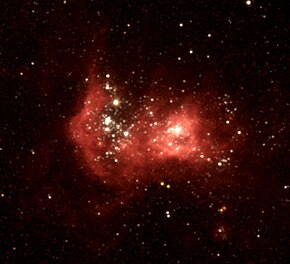| Nebula | |
|---|---|
 A Hubble Space Telescope (HST) image of NGC 2363. A Hubble Space Telescope (HST) image of NGC 2363. | |
| Observation data: J2000 epoch | |
| Right ascension | 07 28 29.6 |
| Declination | +69° 11′ 34″ |
| Distance | z=70 km/s |
| Apparent magnitude (V) | 15.5 |
| Apparent dimensions (V) | 1.7′ × 1.1′ |
| Constellation | Camelopardalis |
| Designations | UGC 3847, MCG +12-07-039, PGC 21078 |
| See also: Lists of nebulae | |
NGC 2363 is a star-forming region in the Magellanic galaxy NGC 2366 which is located in the constellation Camelopardalis. It contains NGC 2363-V1, a luminous blue variable star which is 6,300,000 times more luminous than the Sun and one of the most luminous stars known. It can be seen in this Hubble Space Telescope image as the bright isolated star in the dark void on the left of the nebula.
According to notes by H. G. Corwin Jr. (2004), the cataloged object NGC 2363 refers to the galaxy UGC 3847, while the original object observed by Herschel is the H II region Mrk 71.
References
- ^ "NASA/IPAC Extragalactic Database". Results for NGC 2363. Retrieved 2007-04-06.
- "Hubble Observes a Dwarf Galaxy with a Bright Nebula". ESA/Hubble Press Release. Retrieved 10 May 2012.
- Drissen, Laurent; Roy, Jean-René; Robert, Carmelle (1997). "A New Luminous Blue Variable in the Giant Extragalactic H II Region NGC 2363". The Astrophysical Journal. 474 (1): L35 – L38. Bibcode:1997ApJ...474L..35D. doi:10.1086/310417.
- Corwin, H. G. Jr. "NGC 2363". History and Accurate Positions for the NGC/IC Objects. Retrieved 2020-09-13.
External links
 Media related to NGC 2363 at Wikimedia Commons
Media related to NGC 2363 at Wikimedia Commons- HubbleSite NewsCenter: Pictures and description
| Astronomical catalogs | |
|---|---|
| NGC | |
| PGC | |
| UGC | |
| Constellation of Camelopardalis | |||||||||||||
|---|---|---|---|---|---|---|---|---|---|---|---|---|---|
| Stars |
| ||||||||||||
| |||||||||||||
| |||||||||||||
| |||||||||||||
| Galaxies |
| ||||||||||||
| |||||||||||||
| |||||||||||||
This nebula-related article is a stub. You can help Misplaced Pages by expanding it. |